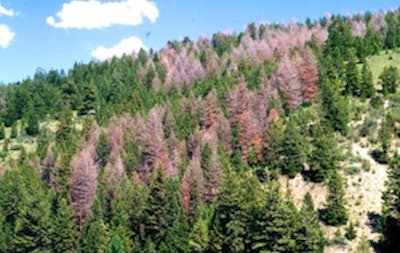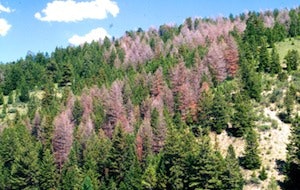

There are many companies offering "blue pine" for wall panel or fencing, and a few who offer it for flooring. I asked a friend of mine, Ryan Palma of Sustainable Lumber Co., to tell me about the resource.
Elizabeth: What is the condition of the Western forests now?
Ryan: Drought and wildfires were always a natural part of the Western forest, but due to fire suppression our forests have become very "un-natural." We haven't allowed Mother Nature to manage and regenerate our forests. We live in the forest and we naturally want to protect it, but our instinct to stop all fires hasn't necessarily been a good thing for the long-term health of our trees. Without fires our forests have become overgrown and crowded.
A healthy Western forest should have 40-60 trees per acre; Montana currently averages between 100-200. Due to drought and mismanagement our trees are significantly stressed-40 trees per acre compete for the same water and soil nutrients as 200 trees per acre. Stressed trees are more susceptible to insect attack. In Utah bark beetles now kill more trees annually than wildfires. Since 1999 Utah has lost approximately 1.7 million trees due to bark beetle infestation, and in Montana we're just as bad or worse.
These beetle-killed trees inevitably dry out and become fuel for catastrophic wildfires in the future. I would much rather get into the woods, take these dead trees out and make more room for the living. Of course I would also like to see some living forests better managed for their health. too.
Elizabeth: But you're focused on the deadwood for business, right?
Ryan: Yes, Sustainable Lumber Co. harvests Montana dead standing Douglas fir logs, which are typically left to rot due to their low economic value for general milling. We try to minimize any additional damage or risk to the forest. In fact, our entire production in 2010 was helicopter-logged as part of the first timber sale under the Healthy Forest Initiative Act. Elizabeth: Why are these considered to be of low economic value?
Ryan: Milling dead timber is an art. There is a reason big-volume commercial sawmills don't like them. Unlike living trees, dead standing timber has significantly more defects like cracking, checking and bug holes. We first try to target beams, then rough-cut boards, then flooring, and finally door stock. Using this method enables us to maximize the fiber harvested from each log. All of our downfall is sold for firewood. We don't waste anything.
We think it's worth the extra work it takes. The Montana Doug fir is a very slow-growing tree. Due to high elevations and low humidity, our trees have a tremendous amount of rings per inch. We average 15-20 rings per inch compared to the 4-6 rings per inch for coastal trees. In addition the majority of our trees are old-growth, averaging 200-300 years old.
We just completed about three months of testing from the College of Forestry at Oregon State University. The feedback from our customers stating the amazing stability of our products prompted us to take a closer look at why. Oregon State took a sample of our wood and a piece of coastal Douglas fir and dried both samples down to about 6% moisture content. They then slowly tried to bring the moisture content back up. Turns out our wood is significantly less prone to swelling compared to the coastal Fir.
They think there has been some sort of alteration in the wood cells after our trees have been exposed to high levels of heat in a forest fire. They sent us the slides of our wood and the coastal Fir under a microscope at 20x power; it's pretty cool to see the difference. The wood cells of our wood almost have a "fuzzy" appearance, kind of resembling a clogged straw, compared to the coastal fir, which looks like a brand new straw.
So the way I see it, these "dead" trees are really very green-it's better for the forest to have us take them out, and potentially they'll give the homeowner a better function, as well.
(Photo courtesy of A. Steven Munson, USDA Forest Service, Bugwood.org)
































